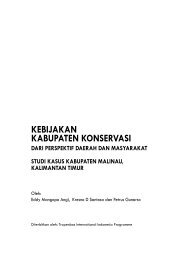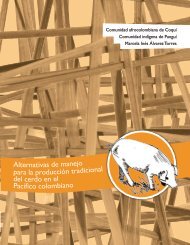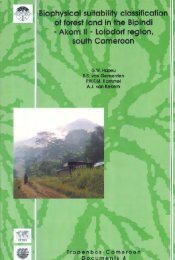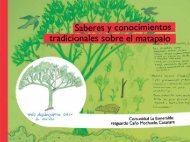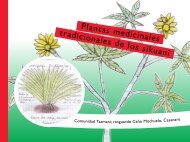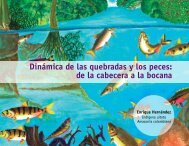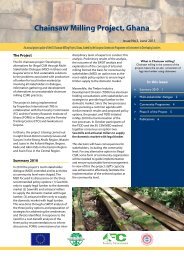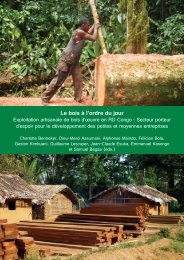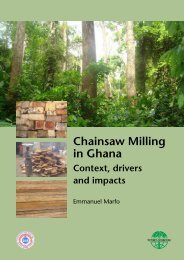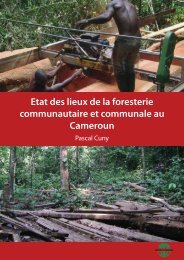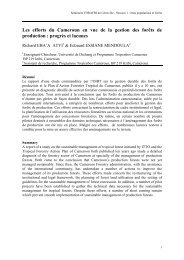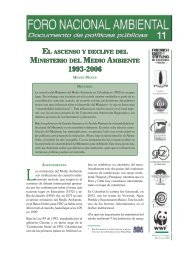Download the publication - Tropenbos International
Download the publication - Tropenbos International
Download the publication - Tropenbos International
Create successful ePaper yourself
Turn your PDF publications into a flip-book with our unique Google optimized e-Paper software.
General conclusions and implications for biodiversity conservation<br />
logging and agro-industrial enterprises. A stakeholder analysis carried out in <strong>the</strong> area<br />
(ERE Développement, 2002) showed that <strong>the</strong>re is an overwhelming concern among<br />
stakeholders about <strong>the</strong> restrictions imposed with <strong>the</strong> creation of <strong>the</strong> National Park.<br />
The creation of <strong>the</strong> park has led to <strong>the</strong> reduction of <strong>the</strong> availability of bush meat<br />
within <strong>the</strong> TOU and <strong>the</strong> reduction of forestland for future agricultural expansion.<br />
Fur<strong>the</strong>rmore, <strong>the</strong> contribution of <strong>the</strong> park to <strong>the</strong> local economy is not yet evident.<br />
Despite <strong>the</strong> efforts made by <strong>the</strong> Campo-Ma’an Project to sensitize <strong>the</strong> local<br />
communities, a large majority is still very skeptical about <strong>the</strong> contribution of<br />
biodiversity conservation to <strong>the</strong>ir livelihoods. Therefore, environmental education<br />
programs should be reinforced in <strong>the</strong> area. This will help to create awareness among<br />
local people, to explain <strong>the</strong> purpose of conservation and <strong>the</strong> reasons for creating <strong>the</strong><br />
National Park, and to educate <strong>the</strong>m on <strong>the</strong> far-reaching implications of forest<br />
degradation. Local people need to learn about <strong>the</strong> importance of community forests<br />
and how to apply, create and manage a community forest. They also need to be<br />
informed on <strong>the</strong> existing laws on forestry, wildlife and fisheries. By doing so, <strong>the</strong><br />
Campo-Ma’an Project will create a conducive working atmosphere that may help to<br />
secure <strong>the</strong>ir active and full participation in any conservation initiatives.<br />
Environmental education should be carried out at all levels, with different target<br />
groups within <strong>the</strong> local communities (traditional leaders, elite, hunters, farmers,<br />
women, children, teachers, etc.), timber exploiters, agro-industrials, local<br />
administrative authorities and any o<strong>the</strong>r stakeholders involved in <strong>the</strong> conservation of<br />
biodiversity in <strong>the</strong> TOU. Simple and appropriate education tools should be used to<br />
offer <strong>the</strong> local communities something that is important, clear, easy to recall and<br />
above all, something that give <strong>the</strong>m food for thought. Dissemination of information<br />
to stakeholders is necessary for <strong>the</strong>ir involvement in <strong>the</strong> decision-making process.<br />
Key findings of all studies carried out in <strong>the</strong> area should be published and made<br />
available to <strong>the</strong> local communities. Simple leaflets with <strong>the</strong> list of plant and wildlife<br />
species of high conservation values should be produced with <strong>the</strong>ir local names,<br />
conservation status and pictures, and distributed to all <strong>the</strong> stakeholders. Regular<br />
broadcasts on television through attractive programmes are vital for <strong>the</strong> presentation<br />
and dissemination of information ga<strong>the</strong>red.<br />
Photo: Natural forest gap rich in fern species (Tchouto, M.G.P.)<br />
123



